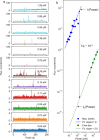Two-Photon-Excited Single-Molecule Fluorescence Enhanced by Gold Nanorod Dimers
- PMID: 35575461
- PMCID: PMC9136919
- DOI: 10.1021/acs.nanolett.2c01219
Two-Photon-Excited Single-Molecule Fluorescence Enhanced by Gold Nanorod Dimers
Abstract
We demonstrate two-photon-excited single-molecule fluorescence enhancement by single end-to-end self-assembled gold nanorod dimers. We employed biotinylated streptavidin as the molecular linker, which connected two gold nanorods in end-to-end fashion. The typical size of streptavidin of around 5 nm separates the gold nanorods with gaps suitable for the access of fresh dyes in aqueous solution, yet small enough to give very high two-photon fluorescence enhancement. Simulations show that enhancements of more than 7 orders of magnitude can be achieved for two-photon-excited fluorescence in the plasmonic hot spots. With such high enhancements, we successfully detect two-photon-excited fluorescence for a common organic dye (ATTO 610) at the single-molecule, single-nanoparticle level.
Keywords: ATTO 610 dye; gold nanorod dimer; plasmonic enhancement; single-molecule bursts; single-molecule fluorescence; two-photon excitation.
Conflict of interest statement
The authors declare no competing financial interest.
Figures




Similar articles
-
Controlled synthesis of gold nanorod dimers with end-to-end configurations.RSC Adv. 2022 May 5;12(21):13464-13471. doi: 10.1039/d2ra01288j. eCollection 2022 Apr 28. RSC Adv. 2022. PMID: 35527728 Free PMC article.
-
Single-Particle Spectroscopic Study on Fluorescence Enhancement by Plasmon Coupled Gold Nanorod Dimers Assembled on DNA Origami.J Phys Chem Lett. 2015 Jun 4;6(11):2043-9. doi: 10.1021/acs.jpclett.5b00747. Epub 2015 May 18. J Phys Chem Lett. 2015. PMID: 26266500
-
Resonant plasmonic enhancement of single-molecule fluorescence by individual gold nanorods.ACS Nano. 2014 May 27;8(5):4440-9. doi: 10.1021/nn406434y. Epub 2014 Apr 4. ACS Nano. 2014. PMID: 24684549
-
Plasmonic Enhancement of Two-Photon-Excited Luminescence of Single Quantum Dots by Individual Gold Nanorods.ACS Photonics. 2018 Jul 18;5(7):2960-2968. doi: 10.1021/acsphotonics.8b00306. Epub 2018 Jun 11. ACS Photonics. 2018. PMID: 30057930 Free PMC article.
-
Accessible hotspots for single-protein SERS in DNA-origami assembled gold nanorod dimers with tip-to-tip alignment.Nat Commun. 2023 Nov 8;14(1):7192. doi: 10.1038/s41467-023-42943-7. Nat Commun. 2023. PMID: 37938571 Free PMC article.
Cited by
-
Future Paths in Cryogenic Single-Molecule Fluorescence Spectroscopy.J Phys Chem C Nanomater Interfaces. 2023 Dec 22;128(1):3-18. doi: 10.1021/acs.jpcc.3c06564. eCollection 2024 Jan 11. J Phys Chem C Nanomater Interfaces. 2023. PMID: 38229590 Free PMC article. Review.
-
Gold nanoparticles modulate macrophage polarization to promote skeletal muscle regeneration.Mater Today Bio. 2025 Mar 11;32:101653. doi: 10.1016/j.mtbio.2025.101653. eCollection 2025 Jun. Mater Today Bio. 2025. PMID: 40151803 Free PMC article. Review.
-
Molecular saturation determines distinct plasmonic enhancement scenarios for two-photon absorption signal.Sci Rep. 2025 Jan 31;15(1):3956. doi: 10.1038/s41598-025-87198-y. Sci Rep. 2025. PMID: 39890867 Free PMC article.
-
Photothermal manipulation of the fringing field in gold nanorod dimers towards the apoptosis of cancerous cells.Sci Rep. 2024 Sep 12;14(1):21292. doi: 10.1038/s41598-024-62898-z. Sci Rep. 2024. PMID: 39266546 Free PMC article.
References
-
- Callis P. R. On the Theory of Two-photon Induced Fluorescence Anisotropy with Application to Indoles. J. Chem. Phys. 1993, 99, 27–37. 10.1063/1.465805. - DOI
-
- Göppert-Mayer M. Über Elementarakte Mit Zwei Quantensprüngen. Ann. Phys. 1931, 401, 273–294. 10.1002/andp.19314010303. - DOI
-
- Franken P. A.; Hill A. E.; Peters C. W.; Weinreich G. Generation of Optical Harmonics. Phys. Rev. Lett. 1961, 7, 118–119. 10.1103/PhysRevLett.7.118. - DOI
-
- Kaiser W.; Garrett C. G. B. Two-Photon Excitation in CaF2: Eu2+. Phys. Rev. Lett. 1961, 7, 229–231. 10.1103/PhysRevLett.7.229. - DOI
Publication types
MeSH terms
Substances
LinkOut - more resources
Full Text Sources

